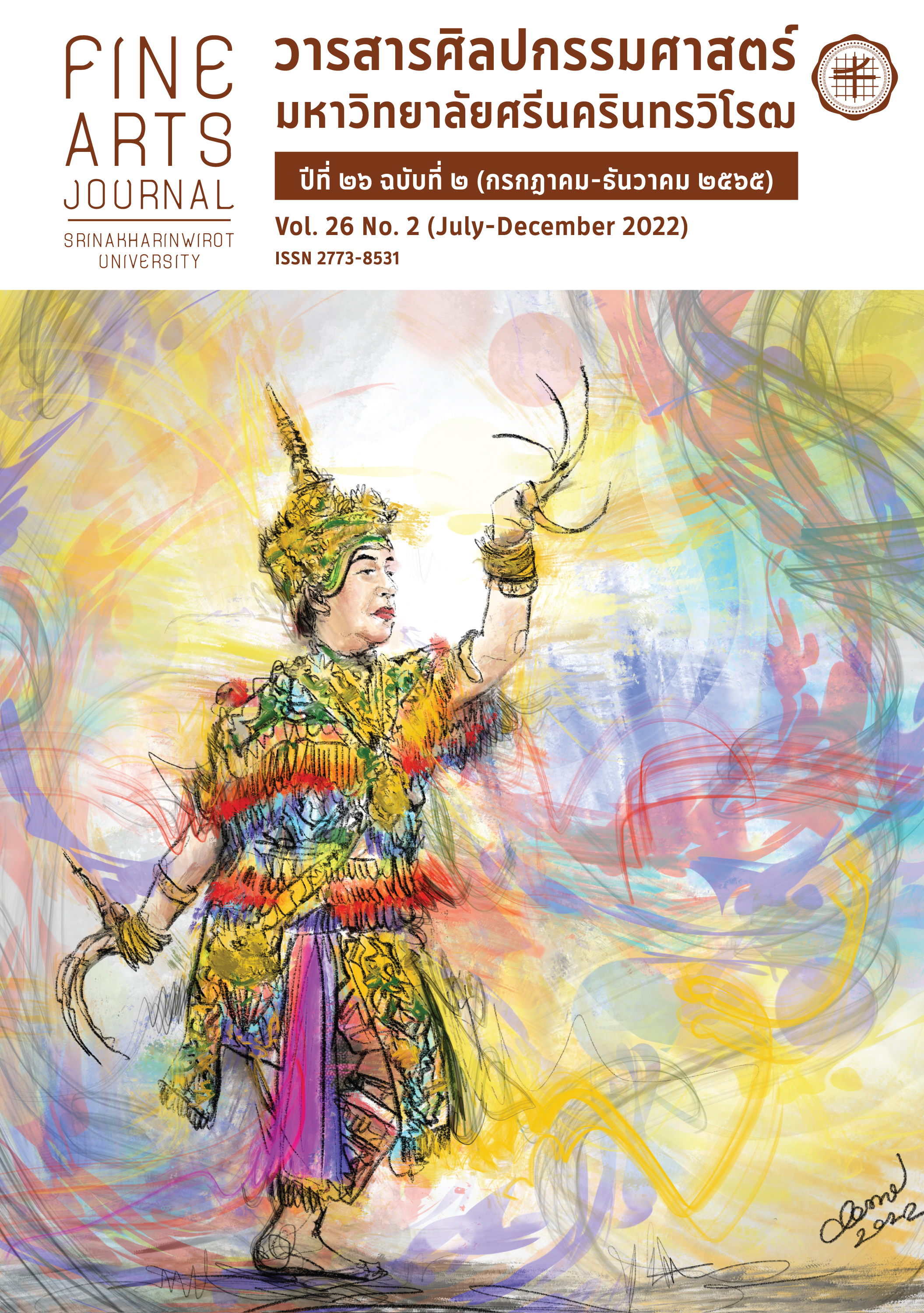THE ANALYSIS OF KHLUI PHIANG OA SOLO ‘LOM PAT CHAI KHAO SAMCHAN’ OF KHRU THIAP KHONGLAITHONG FROM THE RABBIT BRAND, GRAMOPHONE RECORD
Keywords:
Khlui Phiang Oa, Lom Pat Chai Khao Samchan, Khru Thiap Khonglaithong, Rabbit Record Brand, Gramophone recordAbstract
The study of a Khlui Phiang Oa solo in the gramophone records aims to analyze the melodic structure on the Lom Pat Chai Khao Samchan solo song and to analyze the special performing techniques of Khru Thiap Khonglaithong’s rearrangement. The material source of the study was the gramophone records product of the Rabbit Record Brand no.T705/TNC9052. This study employed qualitative data analysis and collected data through library research, observation and interviews with related persons in Thailand. The major findings indicated that the Lom Pat Chai Khao Samchan was defined as ‘Phleng Thang Phuen’ genre which consists of two parts (i.e., A and B). Each part consisted of four Prop Kai cyclic repeated rounds of the rhythmic drum pattern in the third degree (Sam Chan) tempo calculation. The solo piece was particularly systematised in the style of ‘Ot and Phan’ structures. Although, the first part was designed in the form of ‘Ot-Phan-Phan’ (A1, A2/ B2), whilst the second part was merely Phan form. In addition, as the special performing techniques, the outstanding style of Khru Thiap Khonglaithong’s rearrangement used three techniques namely (1) the rhythmic displacement, (2) the ending sound of phrase adjournment and (3) the complicated variation melody creation. The three techniques included using four physical skills are; blowing method, fingering method, tongue method, and integral method. The four methods can be elaborately divided into twelve detailed-techniques which are Tot Lom, Khran, Prakhop Lom, Ti nio, Sabat, Tot Lin, Prip, Hoi, Huan, Kratop, and Proi Siang.
Downloads
References
กรมศิลปากร. (2548). คำบรรยายวิชาดุริยางคศาสตร์ไทย. กรุงเทพมหานคร: พิฆเนศ พริ้นท์ติ้งเซ็นเตอร์.
จรัญ กาญจนประดิษฐ์. (2561). การศึกษาเพลงเดี่ยวจากแผ่นเสียงโบราณ. วารสารครุศาสตร์ จุฬาลงกรณ์มหาวิทยาลัย,
(4), 79-99.
ฐานิสร์ พรรณรายน์. (2553). วิเคราะห์การสอดทำนองเครื่องเป่าในวง 3 ขลุ่ยไทย ทางครูปี๊บ คงลายทอง (วิทยานิพนธ์
ปริญญามหาบัณฑิต). จุฬาลงกรณ์มหาวิทยาลัย, กรุงเทพมหานคร.
บุญช่วย โสวัตร. (2528). การแสดงดนตรีเพลงปี่ ระลึกถึง ครูเทียบ คงลายทอง ประจำวันศุกร์ครั้งที่ 277 ศูนย์สังคีต ธนาคาร
กรุงเทพ จำกัด. สืบค้นเมื่อ 6 พฤษภาคม 2564, จาก https://www.youtube.com/watch?v=0-_BoS7eNGA
ปณิสรา เผือกแห้ว. (2548). เดี่ยวปี่ในเชิดนอก ทางครูปี๊บ คงลายทอง (วิทยานิพนธ์ปริญญามหาบัณฑิต). จุฬาลงกรณ์
มหาวิทยาลัย, กรุงเทพมหานคร.
พิชิต ชัยเสรี. (2559). สังคีตลักษณ์วิเคราะห์. กรุงเทพมหานคร: โรงพิมพ์แห่งจุฬาลงกรณ์มหาวิทยาลัย.
พูนพิศ อมาตยกล, พิชิต ชัยเสรี, อารดา กีระนันท์, วชิราภรณ์ วรรณดี, ประพจน์ อัศววิรุฬหการ, และจรวยพร สุเนตรวรกุล.
(2532). นามานุกรมศิลปินเพลงไทยในรอบ 200 ปี แห่งกรุงรัตนโกสินทร์. กรุงเทพมหานคร: เรือนแก้ว.
มานพ วิสุทธิแพทย์. (2556). ทฤษฎีการวิเคราะห์เพลงไทย. กรุงเทพมหานคร: สันติศิริการพิมพ์.
รณชิต แม้นมาลัย. (2540). เมื่อลมรู้โรย. ใน อานันท์ นาคคง (บรรณาธิการ) อนุสรณ์งานพระราชทานเพลิงศพครูจำเนียร ศรี
ไทยพันธุ์ (หน้า 51-52). กรุงเทพมหานคร: พิฆเนศ พริ้นท์ติ้งเซ็นเตอร์.
ราชบัณฑิตยสถาน. (2550). สารานุกรมศัพท์ดนตรีไทย ภาคประวัติและบทเพลงตับ ประวัติเพลงหน้าพาทย์และเพลงโหมโรง.
กรุงเทพมหานคร: อรุณการพิมพ์.
อุทิศ นาคสวัสดิ์. (2522). ทฤษฎีและการปฏิบัติดนตรีไทยภาคว่าด้วยหลักและทฤษฎีดนตรีไทย. กรุงเทพมหานคร: เจริญการ
พิมพ์.
Mitchell, J.L. (2016). The Rabbit Record Brand of Siam/Thailand 1925-1970: Assessing the legacy of T.
Ngekchuan. Asian Music, 47(2), 48-83.
Downloads
Published
How to Cite
Issue
Section
License

This work is licensed under a Creative Commons Attribution-NonCommercial-NoDerivatives 4.0 International License.






